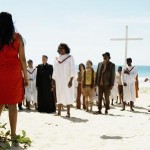Bran Nue Dae: something nue under the WA sun
A retro, indigenous-themed musical satire starring pop stars and an out-of-control Geoffrey Rush? Bran Nue Dae is all that and more, writes Paul Hayes.
They’ve started doing it again in Hollywood. They do it all the time in Bollywood. So why doesn’t Australian cinema make musicals? In terms of genre, the musical has at best been sporadically represented in Australia. Baz Luhrmann has certainly done his best to breathe some local life into the genre from the music and dance oriented Strictly Ballroom, to the out and out musical show piece Moulin Rouge!, but for the most part home-grown musicals just don’t seem to be our thing.
With that in mind, for the first Australian musical to hit our screens since Nicole and Ewan danced in a Paris nightclub to be a retro, indigenous road movie is certainly one from outside the box. Director Rachel Perkins’ Bran Nue Dae has seemingly created a new niche within cinema all by itself.


